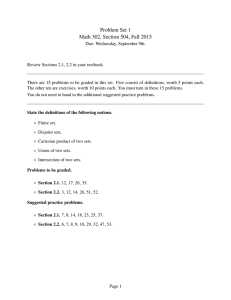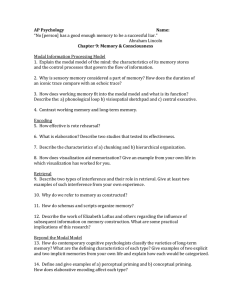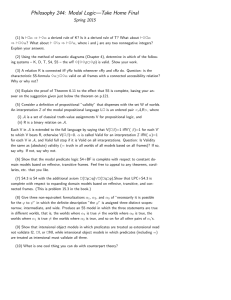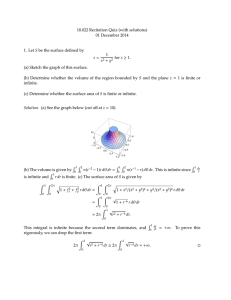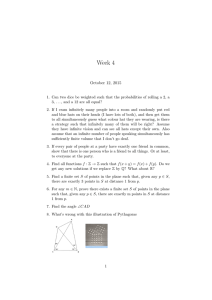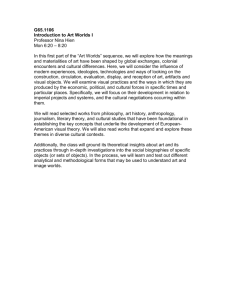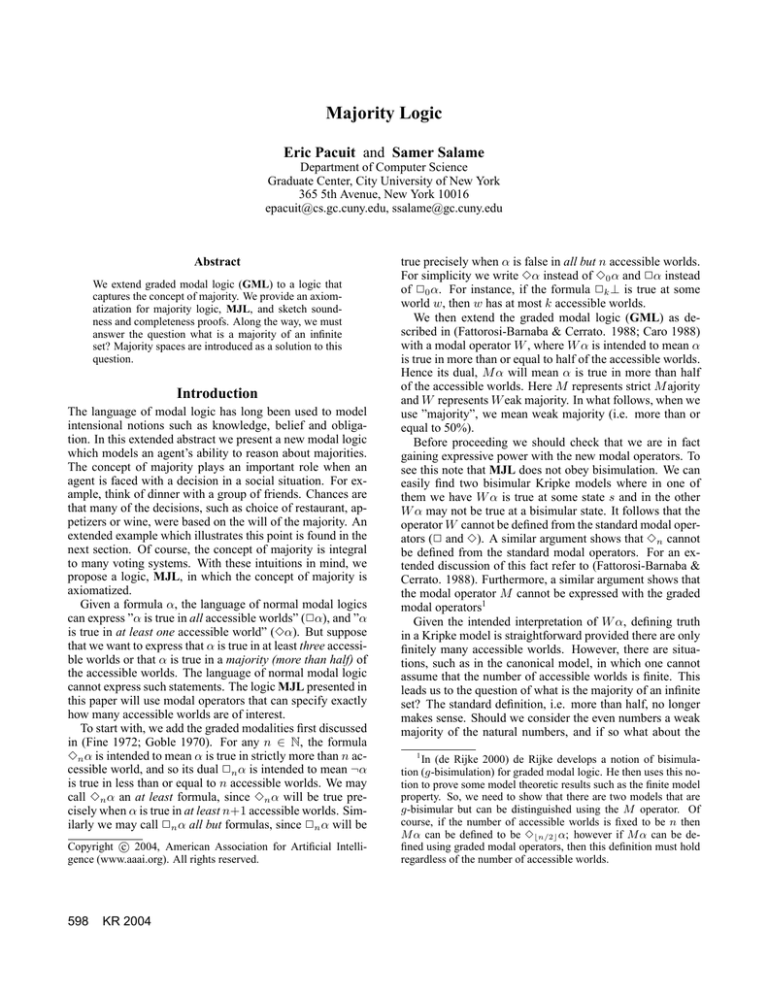
Majority Logic
Eric Pacuit and Samer Salame
Department of Computer Science
Graduate Center, City University of New York
365 5th Avenue, New York 10016
epacuit@cs.gc.cuny.edu, ssalame@gc.cuny.edu
Abstract
We extend graded modal logic (GML) to a logic that
captures the concept of majority. We provide an axiomatization for majority logic, MJL, and sketch soundness and completeness proofs. Along the way, we must
answer the question what is a majority of an infinite
set? Majority spaces are introduced as a solution to this
question.
Introduction
The language of modal logic has long been used to model
intensional notions such as knowledge, belief and obligation. In this extended abstract we present a new modal logic
which models an agent’s ability to reason about majorities.
The concept of majority plays an important role when an
agent is faced with a decision in a social situation. For example, think of dinner with a group of friends. Chances are
that many of the decisions, such as choice of restaurant, appetizers or wine, were based on the will of the majority. An
extended example which illustrates this point is found in the
next section. Of course, the concept of majority is integral
to many voting systems. With these intuitions in mind, we
propose a logic, MJL, in which the concept of majority is
axiomatized.
Given a formula α, the language of normal modal logics
can express ”α is true in all accessible worlds” (2α), and ”α
is true in at least one accessible world” (3α). But suppose
that we want to express that α is true in at least three accessible worlds or that α is true in a majority (more than half) of
the accessible worlds. The language of normal modal logic
cannot express such statements. The logic MJL presented in
this paper will use modal operators that can specify exactly
how many accessible worlds are of interest.
To start with, we add the graded modalities first discussed
in (Fine 1972; Goble 1970). For any n ∈ N, the formula
3n α is intended to mean α is true in strictly more than n accessible world, and so its dual 2n α is intended to mean ¬α
is true in less than or equal to n accessible worlds. We may
call 3n α an at least formula, since 3n α will be true precisely when α is true in at least n+1 accessible worlds. Similarly we may call 2n α all but formulas, since 2n α will be
c 2004, American Association for Artificial IntelliCopyright gence (www.aaai.org). All rights reserved.
598
KR 2004
true precisely when α is false in all but n accessible worlds.
For simplicity we write 3α instead of 30 α and 2α instead
of 20 α. For instance, if the formula 2k ⊥ is true at some
world w, then w has at most k accessible worlds.
We then extend the graded modal logic (GML) as described in (Fattorosi-Barnaba & Cerrato. 1988; Caro 1988)
with a modal operator W , where W α is intended to mean α
is true in more than or equal to half of the accessible worlds.
Hence its dual, M α will mean α is true in more than half
of the accessible worlds. Here M represents strict M ajority
and W represents W eak majority. In what follows, when we
use ”majority”, we mean weak majority (i.e. more than or
equal to 50%).
Before proceeding we should check that we are in fact
gaining expressive power with the new modal operators. To
see this note that MJL does not obey bisimulation. We can
easily find two bisimular Kripke models where in one of
them we have W α is true at some state s and in the other
W α may not be true at a bisimular state. It follows that the
operator W cannot be defined from the standard modal operators (2 and 3). A similar argument shows that 3n cannot
be defined from the standard modal operators. For an extended discussion of this fact refer to (Fattorosi-Barnaba &
Cerrato. 1988). Furthermore, a similar argument shows that
the modal operator M cannot be expressed with the graded
modal operators1
Given the intended interpretation of W α, defining truth
in a Kripke model is straightforward provided there are only
finitely many accessible worlds. However, there are situations, such as in the canonical model, in which one cannot
assume that the number of accessible worlds is finite. This
leads us to the question of what is the majority of an infinite
set? The standard definition, i.e. more than half, no longer
makes sense. Should we consider the even numbers a weak
majority of the natural numbers, and if so what about the
1
In (de Rijke 2000) de Rijke develops a notion of bisimulation (g-bisimulation) for graded modal logic. He then uses this notion to prove some model theoretic results such as the finite model
property. So, we need to show that there are two models that are
g-bisimular but can be distinguished using the M operator. Of
course, if the number of accessible worlds is fixed to be n then
M α can be defined to be 3bn/2c α; however if M α can be defined using graded modal operators, then this definition must hold
regardless of the number of accessible worlds.
set that contains all the even numbers plus the set {1, 3}?
Mark Fey in (Fey 2002) proposes some interesting answers
to this question. However, Fey’s solutions are not appropriate for our framework and so we need another solution. We
propose majority spaces, which generalize the concept of an
ultrafilter, as a solution to the problem of defining a majority
of an infinite set.
This extended abstract is organized as follows. The next
section reviews graded modal logic. We then describe the
language of majority logic and offer an axiomatization. After introducing majority spaces, we provide a Kripke style
semantics and sketch the completeness proof.
Graded Modal Logic
In this section, we provide a brief overview of graded
modal logic. Graded modal logic was first introduced in
(Fine 1972; Goble 1970). It was then studied in (FattorosiBarnaba & Cerrato. 1988; H. J. Ohlbach & Hustadt 1995;
Caro 1988; de Rijke 2000; Tobies 2001) in which issues of
axiomatization, completeness, decidability and translations
into predicate logic are discussed. We briefly discuss the
language of graded modal logic and state some of the main
results found in the literature. All results and proofs can
be found in (Fattorosi-Barnaba & Cerrato. 1988) and (Caro
1988).
Definition 1 Given a countable set of atomic propositions
P = {p0 , p1 , . . .}, a formula α of GML can have the following syntactic form:
α := p | ¬α | α ∨ α | 3n α
where p ∈ P and n ∈ N.
For each n ∈ N, we define 2n α := ¬3n ¬α, and
3!n α := 3n−1 α ∧ ¬3n α (n 6= 0) where 3!0 α := ¬30 α.
So 3!n α will have the intended meaning that α is true in
exactly n accessible worlds. Let LGML be the set of all wellformed formulas of GML.
The following axiomatization was presented in (Caro
1988).
G0 All tautologies in the language of GML
G1 3n+1 α → 3n α
(n ∈ N)
G2 20 (α → β) → 3n α → 3n β
(n ∈ N)
G3 3!0 (α ∧ β) → ((3!n1 α ∧ 3!n2 β) → 3!n1 +n2 (α ∨
β)) (n1 , n2 ∈ N)
GML is closed under modus ponens (M P ) and necessitation (N ), i.e., from ` α infer ` 2α. We write `GML α if α
can be deduced from G0 − G1 using the rules M P and N .
GML formulas are interpreted in the usual Kripke structures. Let M = hS, R, V i be a Kripke model, where S is a
set of worlds, R is a binary relation over S and V : P → 2S
is a valuation function. The boolean connectives and propositional variables are evaluated as usual. We will only show
how the formula 3n α is evaluated at a world s ∈ S:
M, s |= 3n α iff |{t : sRt and M, t |= α}| > n
We say α is valid in M iff ∀s ∈ S, M, s |= α, and
write M |= α. We write |= α if α is valid in all models (based on some class of frames2 ) We also make use
of the following notation throughout this paper: R(s) =
{t | sRt} and for any formula α (of MJL or GML),
Rα (s) = {t | sRt and t |= α}. So, the above definition
can be rewritten as
M, s |= 3n α iff |Rα (s)| > n
GML is shown to be sound and complete with respect
to the class of all frames in (Fattorosi-Barnaba & Cerrato.
1988). Let F be the class of all frames. It is easily verified
that the axioms G0 − G1 are valid in any model based on F
and M P and N preserve validity. We state the completeness
theorem below, but postpone discussion until later in this
paper.
Theorem 1 (Completeness of GML) Let F be the class of
all frames. Then for any formula α of GML, |= α iff `GML α.
In (Caro 1988) GML is shown to be decidable by showing that GML has the finite model property. Maarten de
Rijke (de Rijke 2000) arrives at the same conclusion using
an extended notion of bisimulation appropriate for a modal
language with graded modalities. de Rijke also establishes
invariance and definability results. Finally in (Tobies 2001),
Tobbies shows that the decidability problem for GML is in
P SP ACE.
Majority Logic: Syntax
We extend the graded modal language with a new modal
operator W where W is interpreted as ”weak majority.”
Definition 1 Given a countable set of atomic propositions
P = {p0 , p1 , . . .}, a formula α of MJL can have the following syntactic form:
α := p | ¬α | α ∨ α | 3n α | W α
where p ∈ P and n ∈ N.
Let LMJL be the set of all well-formed formulas of the
majority modal logic. Define M α := ¬W ¬α. So, MJL
takes the language of GML and closes under the operator
W . Notice in particular that there are an infinite number
of modal operators, one for each natural number plus the
majority operators.
Axiomatization
We propose the following axiomatization of MJL. Since
MJL extends graded modal logic, we will include the axiom schemes G1, G2 and G3. These axioms captures our
intuitions when we can count accessible worlds. But what
axioms shall we adopt to reason about “majority”? The following discussion will motivate the proposed axiomatization
which can be found at the end of the discussion.
2
Unless otherwise stated we will assume that we are working
with models based on the class of all frames. Refer to (Blackburn,
de Rijke, & Venema 2001) for more information on frames.
KR 2004
599
Suppose a group of friends are trying to decide where to
go for dinner. As is common in most social situations, the
goal is to keep as many people happy as possible. If more
than half of the people want Indian for dinner and more than
half want Italian for dinner, then there must be someone who
wants both Italian and Indian. This is easy to see if we consider a specific example. If there are 10 friends deciding
on dinner and 6 people want Indian and 6 people want Italian, then obviously at least someone wants both Indian and
Italian3 . This reasoning is captured by the following axiom
scheme
M α ∧ M β → 3(α ∧ β)
Now, suppose that more than half of the friends want Italian for dinner. Also, suppose that every time the group
eats Italian where wine is always served with Italian food.
We can conclude that a majority of the friends want wine
with dinner. And so, we will included the following axiom
scheme
M α ∧ (α → β) → M β
Suppose that you are put in charge of making dinner reservations for the group of 10 people. Given that 5 people prefer Italian and 5 people prefer Indian, what can you conclude
if you are given additional information that more that 3 people do not like Italian and do not like Indian. The natural
conclusion to draw is that more than 3 people like Indian
and Italian food. Otherwise, say you conclude that only two
people like both Indian and Italian food. This would mean
that 3 people like Italian but not Indian, 3 people like Indian
but not Italian and (more than ) 3 people like neither Indian
nor Italian. Since these sets are disjoint, the total sum of
people is 11 or more, and so it must be the case that more
than 3 people like Indian and Italian. This line of reasoning
is captured by the following axiom scheme
W α ∧ W β ∧ 3n (¬α ∧ ¬β) → 3n (α ∧ β)
(n ∈ N)
The final situation is similar to the above situation. except
suppose that a majority of the people prefer Italian.
W α ∧ M β ∧ 3n (¬α ∧ ¬β) → 3n+1 (α ∧ β)
(n ∈ N)
The preceding discussion is summarized by the following
list of axioms and rules.
Axiom 1 Classical propositional tautologies
Axiom 2 3n+1 α → 3n α (n ∈ N)
Axiom 3 (α → β) → (3n α → 3n β) (n ∈ N)
Axiom 4 3!0 (α∧β) → ((3!n1 α∧3!n2 β) → 3!n1 +n2 (α∨
β)) (n1 , n2 ∈ N)
Axiom 5 M α ∧ M β → 3(α ∧ β)
Axiom 6 M α ∧ (α → β) → M β
Axiom 7 W α∧W β∧3n (¬α∧¬β) → 3n (α∧β) (n ∈ N)
3
Of course two people could have said that they don’t care
where they eat. This is not the same as two people saying that
they want both Italian and Indian, but for the purposes of this example we will assume that a ”don’t care” vote is a vote for both
options
600
KR 2004
Axiom 8 W α∧M β∧3n (¬α∧¬β) → 3n+1 (α∧β) (n ∈
N)
MP From α and α → β derive β.
NEC From α derive 2α.
We write `MJL α if α can be deduced from Axioms 1 - 8
using the rules M P and N . If it is clear from context, we
may write ` α instead of `MJL α.
Properties of the Axioms
We now discuss some of the properties of the axioms proposed in the previous section. Some of these properties turn
out to be useful in the completeness proof and others are
natural properties of majorities and weak majorities.
This first lemma gives some consequences of the proposed axioms. The lemma also shows that our axiomatization captures many natural properties of ”majority” and
”weak majority”. Part (i) shows M and W are both normal
modal operators. Part (ii) is equivalent to saying that given
any set X and any subset of X either it or its complement
(or both) constitutes weak majority of X. (iii) - (viii) are
obvious properties of majority and weak majority sets.
Lemma 2 Suppose that α and β are arbitrary formulas of
MJL. Then
i.
ii.
iii.
iv.
v.
vi.
vii.
viii.
If ` α → β then ` M α → M β and ` W α → W β.
` W α ∨ W ¬α
` M α → W α and ` M α → 3α
` ¬M ⊥
` α → W α
` M α ∧ W β → 3(α ∧ β)
` W α ∧ 3(¬α ∧ β) → M (α ∨ β)
` W α ∧ W β ∧ ¬3(α ∧ β) → ¬3(¬α ∧ ¬β)
Proof Suppose that α and β are any formulas of MJL.
i. Suppose that ` α → β. We will show ` M α → M β and
` W α → W β. By the N EC, ` 2(α → β), and so by
modus ponens and Axiom 6, ` M α → M β. ` W α →
W β follows easily using contraposition.
ii. ` ¬3(α ∧ ¬α) → ¬(M ¬α ∧ M α) is an instance of
Axiom 5. Hence ` 2> → (W α ∨ W ¬α). By N EC
` 2>. Therefore by M P , ` W α ∨ W ¬α.
iii. ` M α → W α follows from (ii), and ` M α → 3α is an
instance of Axiom 5.
iv. Using (iii) we get ` ¬3⊥ → ¬M ⊥, and hence ` ¬M ⊥.
v. Using axiom 5 ` ¬3(¬α ∧ ¬α) → ¬(M ¬α ∧ M ¬α)
which is ` α → W α
vi. Note by axiom 6 we have
` M α ∧ 2(α → ¬β) → M ¬β. So we have ` M α ∧
W β → ¬2(α → ¬β) and so using propositional calculus
` M α ∧ W β → 3(α ∧ β)
vii. W α ∧ 3(¬α ∧ β) → W α ∧ 3(¬α ∧ (α ∨ β)) ∧ 2¬(α ∧
¬(α ∨ β)) but we have W α ∧ 3(¬α ∧ (α ∨ β)) ∧ 2¬(α ∧
¬(α ∨ β)) → M (α ∨ β)
viii. By lemma 2-(vi) as a substitution instance, we get `
W α ∧ M (β ∨ ¬α) → 3(α ∧ β) which is equivalent to
` W α ∧ ¬3(α ∧ β) → ¬M (β ∨ ¬α), but the above item
of the lemma, ` W β ∧ 3(¬α ∧ ¬β) → M (β ∨ ¬α). Thus
we get ` W β ∧ W α ∧ ¬3(α ∧ β) → W β ∧ ¬M (β ∨ ¬α)
and hence ` W β ∧ ¬M (β ∨ ¬α) → ¬3(¬α ∧ ¬β)
Using the language of graded modal logic, we can find a
formula that expresses exactly how many worlds are accessible at any given state. For any n ∈ N, the formula 3n !>
will be true at some world w iff there are exactly n accessible worlds. Similarly, the formulas 2n ⊥ will be true at
some world w iff there are at most n accessible worlds. We
will define An := 3n !>, A≤n := 2n ⊥ and A>n := 3n >.
So, An is true at a state s if there are exactly n accessible
worlds. The following lemma show what happens when we
know the exact number of accessible worlds.
Lemma 3 Suppose that An is the formula defined above.
Then
i. ` An → (2bn/2c α ∨ 2bn/2c ¬α) For all n ∈ N
ii. ` An → (2bn/2c−1 α → 3bn/2c α) For all n > 2
iii. For all n ∈ N, ` An → (M α ↔ 3bn/2c α).
Proof Part (i) and (ii) are statements of graded modal
logic, and given the completeness and soundness proofs
in (Caro 1988; Fattorosi-Barnaba & Cerrato. 1988), follow
easily from semantic arguments. We first note the following
properties which are instances of Axioms 8 and 7 respectively (let β = α).
1. ` M α ∧ 3n ¬α → 3n+1 α
2. ` W α ∧ 3n ¬α → 3n α
We need only show property (iii).
• Suppose that ` An ∧ 3bn/2c α. By part (i) of this lemma
we get ` An ∧ 3bn/2c α → 2bn/2c α and by (2) we get
` An ∧ 3bn/2c α ∧ 2bn/2c α → M α
• Suppose that ` An ∧ M α. If n = 0 or n = 1 then we
have M α → 3α so we get 3bn/2c α. Assume n > 2 by
(1) we have M α → (3bn/2c α ∨ 2bn/2c−1 α). Using part
(ii) of this lemma we get ` An ∧ M α → 3bn/2c α
Majority Logic: Semantics
In this section we will present the semantics for MJL. As
usual, formulas of MJL will be interpreted over Kripke
models. The formula W α will be true provided that the
set of all accessible worlds in which α is true is a majority
of the set of all accessible worlds. The definition makes
sense only if there are finitely many accessible worlds. But
what constitutes a majority of an infinite set? The following
section offers a solution to this question.
Recall that if S is any set of states and R a binary relation
on S, then R(s) = {t | sRt} and for any formula α (of MJL
or GML), Rα (s) = {t | sRt and t |= α}. This definition of
course depends on the definition of truth in a model which
is given below.
Majority Spaces
A very interesting situation arises when a Kripke model is
not finitely generated, that is when R(s) may be infinite for
some state s ∈ S. While the semantics of a majority subset is very clear in the finite case, it is not clear what should
constitute a majority when there are an infinite number of
possibilities. We cannot for example stipulate that every infinite set is a (strict) majority. This would create the unsatisfactory situation where a set and it’s complement could be a
majority.
Another natural choice would be to call a set X ⊆ R(s)
a majority if X C is finite, i.e take the majority sets to be the
co-finite sets. However, suppose that R(s) = X1 ∪X2 ∪X3 ,
where X1 , X2 , and X3 are nonempty pairwise disjoint sets
Then one would expect that for some i and j where i 6= j,
Xi ∪ Xj would be a majority. This is certainly true in
the finite case, and so one would expect it to be true in
the infinite case. However, it is easy to come up with an
example where all of the Xi are infinite; and so, none of the
Xi ∪ Xj would be a majority.
Instead of trying to define a majority set as some special
subset of R(s), we will let a model stipulate which sets are
to be considered a majority.
Definition 2 Let W be any set. We will call any set M ⊆
2W a majority system if it satisfies the following properties.
M1. If X ⊆ W , then either X ∈ M or X C ∈ M.
M2. If X ∈ M, Y ∈ M and X ∩ Y = ∅, then Y = X C .
M3. Suppose that X ∈ M and F ⊆ X is any finite set.
If G is any set where G ∩ X = ∅ and |F | ≤ |G|, then
(X − F ) ∪ G ∈ M.
The pair hW, Mi will be called a weak majority space.
Given a set W , a set X ⊆ W will be called a strict majority
(with respect to M) if X ∈ M and X C 6∈ M. X will be
called a weak majority if X ∈ M and X C ∈ M. We
need to check that the above properties correspond to our
intuitions about majority sets. We will call any set X ∈ M
a majority set.
It is easy to see that majority spaces are closed under superset. We show that many of the intuitions we have about
majority sets on a finite space remain in a majority space.
For example, we show that given any majority set X, if we
add something new to X, then this new formed set will be a
strict majority. We also show that if a set W is infinite, then
all majority sets must also be infinite.
Lemma 4 If X is a weak majority and F 6= ∅ is a set such
that F 6⊆ X, then X ∪ F is a strict majority.
Proof Suppose that X is a weak majority and F 6= ∅ is any
set such that F 6⊆ X. Notice first that since X ∈ M and
X ⊆ X ∪ F , X ∪ F ∈ M by fact ?? (this is true for any
set F ). We need only show that (X ∪ F )C 6∈ M. Suppose
that (X ∪ F )C ∈ M. By property M2, since X ∈ M,
(X ∪ F )C ∈ M and X ∩ (X ∪ F )C = ∅, we must have
(X∪F )C = X C which implies F ⊆ X. But this contradicts
the assumption that F 6⊆ X.
KR 2004
601
Lemma 5 Suppose that hW, Mi is a majority space and
that W is infinite. If X ∈ M then X is infinite.
Proof Suppose that hW, Mi is a majority space and W is
infinite. Suppose that X ⊆ W is finite and X ∈ M. Note
that since X is finite, X C is infinite. Take any finite set
G ⊂ X C , where |X| ≤ |G| (such a set must exist since W
is infinite). Then by property M3, (X − X) ∪ G = G ∈ M;
and so, by property M2, G = X C . But this is a contradiction
since G is finite and X C is infinite.
This last proposition demonstrates that our notion of an
infinite majority is equivalent to the natural notion of a majority when we only have a finite number of elements. In
other words, we will show that if W is a finite set, then the
majority sets are the sets that have more than or equal to half
of the elements. We will also show that when W is finite,
the sets that can be called a majority (i.e. satisfy properties
M1-M3) are the sets that have more than or equal to half of
the elements.
Proposition 6 Suppose that W is a finite set and that M0 =
{M ⊆ W : |M | ≥ |W |/2}, Then
hW, M0 i is a majority space
Furthermore, if hW, Mi is any other majority space then
M = M0 .
Proof Suppose that W is a finite set and M0 is as defined
above. We must first show that hW, M0 i is a majority space.
For any set, X ⊆ W , since |X| + |X C | = |W |, either
|X| ≥ |W |/2 or |X C | ≥ |W |/2 and so either X ∈ M0 or
X C ∈ M0 . Hence property M1 is satisfied. For property
M2, suppose that X, Y ∈ M0 , and X ∩ Y = ∅. Since
|X| ≥ |W |/2 and |Y | ≥ |W |/2, |X| + |Y | ≥ |W |. But
since X ∪ Y ⊆ W , |X ∪ Y | ≤ |W | and so |X ∪ Y | = |W |.
Therefore, X ∪ Y = W (this follows since X and Y are
assumed to be subsets of W ). Since X and Y are disjoint
and X ∪ Y = W , then Y = X C . Finally we need to show
that property M3 is satisfied. Suppose that X ∈ M0 . Then
|X| ≥ |W |/2. Suppose that F ⊆ X and G is any finite set
such that |F | ≤ |G| and G ∩ X = ∅. Then
|(X − F ) ∪ G| = |(X − F )| + |G| − |(X − F ) ∩ G|
= |X − F | + |G|
≥ |X − F | + |F |
= |X ∪ F | = |X| ≥ |W |/2
so, (X − F ) ∪ G ∈ M0 .
Let hW, Mi be any majority space and let X ∈ M. We
must now show that |X| ≥ |W |/2. Suppose not, that is
suppose that |X| < |W |/2. Therefore |X C | > |X|. Let
Y ⊆ X C and |Y | = |X| (such a set must exist since |X C | >
|X|). Then by property M3, since |X| ≤ |Y | and Y ∩ X =
∅, (X − X) ∪ Y = Y ∈ M. But by property M2, Y = X C .
But this is a contradiction, since |X| < |W |/2 and |Y | <
|W |/2. Hence, |X| ≥ |W |/2.
602
KR 2004
Example of a majority space In this section we provide
concrete example of a majority space. Furthermore, we
show that this majority space is not an ultrafilter.
Given a set W , a filter F is any non-empty collection of
subsets of W that is closed under intersection and superset.
A filter is an ultrafilter if for all sets A either A ∈ F or AC ∈
F. Finally, F is principal if F contains a singleton, and
F is non-principal if it is not principal (hence contains all
cofinite sets). Given any infinite set, Zorn’s lemma implies
the existence of a non-principal ultrafilter.
Let X1 , X2 , X3 be three disjoint sets such that each Xi is
infinite. Let Ui be a non-principal ultrafilter over Xi . Now
Let X = X1 ∪ X2 ∪ X3 . Define
M = {x|∃i 6= j such that x ∩ Xi ∈ Ui and x ∩ Xj ∈ Uj }
We claim that (X, M) is a majority space. Here is the proof:
M1 Take x ⊆ X. Assume x 6∈ M then assume without loss of
generality that x ∩ X1 6∈ U1 and x ∩ X2 6∈ U2 . Then from
the definition of the ultrafilter we have: xC ∩ X1 ∈ U1
and xC ∩ X2 ∈ U2 . So xC ∈ M
M2 Let x ∈ M, y ∈ M and x ∩ y = ∅ Since we only have
three sets X1 , X2 , X3 then there is i such that x∩Xi ∈ Ui
and y ∩ Xi ∈ Ui . So x ∩ y ∈ Ui and thus ∅ ∈ Ui which
is a contradiction.
M3 x ∈ M and Let y = (x − f ) ∪ g where f in a finite subset
of x and |f | ≤ |g|. The proof goes easily using two facts:
Fact 1 if xi ∈ Ui then for any finite set f ∈ Xi we have xi −
f ∈ Ui .
proof: suppose (xi − f ) 6∈ Ui then Xi − (xi − f ) ∈ Ui .
So (Xi − (xi − f )) ∩ xi ∈ Ui and that is f ∈ Ui which
a contradiction since Ui is a non-principal ultrafilter.
Fact 2 if xi ∈ Ui then for any g ∈ Xi we have xi ∪ g ∈ Ui
Hence (X, M) is a majority space. Notice that X1 ∪X2 ∈
M and X2 ∪ X3 ∈ M but their intersection X2 6∈ M. So
M is not an ultrafilter over X. It should be clear that this
example can be generalized to any odd number of disjoint
sets.
Majority Models
In this section we will extend the definition of a Kripke
model in order to define truth of a majority logic formula.
Definition 3 A majority model is a tuple M =
hS, R, V, mi. Where S is any set of states, R is an accessibility relation and V is the valuation function V : P → 2S ,
S
and m : S → 22 is a majority function such that for each
s ∈ S, hR(s), m(s)i is a majority space.
So, m assigns a majority space to each state. Let s ∈ S be
any state. We will define truth of a formula α at state s in
model M as follows:
1.
2.
3.
4.
5.
M, s |= p iff s ∈ V (p), where p ∈ P
M, s |= ¬α iff M, s 6|= α
M, s |= α ∨ β iff M, s |= α or M, s |= β
M, s |= 3n α iff |Rα (s)| > n (n ∈ N)
M, s |= W α iff Rα (s) ∈ m(s)
And so M, s |= M α iff R¬α (s) 6∈ m(s). First notice that
if R(s) is finite for each s ∈ S, then by proposition 6, then
M, s |= W α iff |Rα (s)| ≥ |R(s)|/2. We will now show
that the axioms of majority logic are valid in all majority
models.
Theorem 7 MJL is sound with respect to the class of all
majority models.
Proof Soundness was shown in (?) for axioms 1 - 4, MP,
and Nec. Let M = hS, R, V, mi be any majority model and
s ∈ S. We will show Axiom 5 - 8 are true at state s. Since s
is arbitrary, each axiom will be valid in M; and hence, the
axioms are sound. All of the proofs are straightforward and
are left to the reader. As an example, we show the result
holds for Axiom 7 and 8.
Axiom 7: Assume s |= W α∧W β ∧3n (¬α∧¬β) so we
have Rα (s) ∈ m(s), Rβ (s) ∈ m(s) and |R¬α∧¬β (s)| > n
Assume
we need to prove that |Rα∧β (s)| > n.
|Rα∧β (s)| ≤ n. Let X ⊂ R¬α∧¬β (s) where |X| = n (X
is a proper subset). Let Y = (Rβ (s) − Rα∧β (s)) ∪ X
according to M3 Y ∈ m(s) and we have Y ∩ Rα (s) = ∅
C
(s) which is a contradiction with M2. So
and Y 6= Rα
|Rα∧β (s)| > n and thus s |= 3n (α ∧ β)
Axiom 8: Assume s |= W α ∧ M β ∧ 3n (¬α ∧ ¬β) so we
have Rα (s) ∈ m(s), R¬β (s) 6∈ m(s) and R¬α∧¬β (s) >
n we need to prove that |Rα∧β (s)| > n + 1. Assume
|Rα∧β (s)| ≤ n + 1. But R¬β (s) = (Rα (s) − Rα∧β (s)) ∪
R¬α∧¬β (s) and by M3 we get R¬β (s) ∈ m(s) which is a
contradiction.
Completeness
We adapt the proof of (Fattorosi-Barnaba & Cerrato. 1988)
to show completeness for MJL. This section will sketch the
completeness proof.
Given any consistent set of formulas of majority logic, Γ,
using Lindenbaum’s Lemma, we can construct a maximally
consistent superset of Γ. As usual, the states of our canonical
model will be maximally consistent sets. In what follows, Γ
will always be assumed to be a maximally consistent set of
formulas.
When constructing a canonical model for a graded modal
logic, it is necessary to control the number of worlds accessible from any given state. Given any state, i.e. maximally
consistent set, Γ, our goal is to construct R(Γ) such that
3n α ∈ Γ iff |{Γ0 ∈ R(Γ) | α ∈ Γ0 }| > n
We will construct a satisfying family for each Γ, denoted
by SF (Γ) so that we may define R(Γ) = SF (Γ) and then
R will satisfy the above property. To this end we will
present the following definitions and lemmas from (Caro
1988). Recall that ω is the first countable ordinal, and that
ω+1 = ω∪{ω}. Let Φ be the set of all maximally consistent
sets.
Definition 4 The function µ : Φ × Φ → ω + 1 is defined as
follows: for every Γ1 , Γ2 ∈ Φ
µ(Γ1 , Γ2 )
µ(Γ1 , Γ2 )
= ω if for any α ∈ Γ2 , 3n α ∈ Γ1 for all n ∈ N
= min{n ∈ N : 3!n α ∈ Γ and α ∈ Γ2 } o.w.
The function µ is well defined (refer to (Fattorosi-Barnaba
& Cerrato. 1988; Caro 1988) for more about this function).
The following lemma is an easy consequence of definition 4
The main idea is that µ will tell us how many accessible
worlds are needed. Given two maximally consistent sets,
Γ1 , Γ2 , µ(Γ1 , Γ2 ) tells us the minimum number of copies of
Γ2 that are needed to be accessible from Γ1 .
We are now ready to define the satisfying family of a
maximally consistent set Γ0 .
Definition 5 Let Γ0 ∈ Φ. The set
[
SF (Γ0 ) = {{Γ} × µ(Γ0 , Γ) : Γ ∈ Φ}
will be called the satisfying family of Γ0 .
An element of SF (Γ0 ) is of the form hΓ, ni where n <
µ(Γ0 , Γ) , therefore we shall think of SF (Γ0 ) as made up of
µ(Γ0 , Γ) ordered copies of Γ, for any Γ ∈ Φ.
The following theorem is the main theorem from (Caro
1988).
Theorem 8 For any α and any n ∈ N,
3n α ∈ Γ0 iff |{Γ ∈ SF (Γ0 ) : α ∈ Γ}| > n
where to simplify notations, we identify a couple hΓ, ni (n <
µ(Γ0 , Γ)) with its first component.
We can now define the canonical for majority logic. We
define the canonical model MΛ = hS Λ , RΛ , V Λ , mΛ i for
MJL as follows, where Λ is a consistent set of majority logic
formulas. First of all, let
µ(Γ) = sup{µ(Γ0 , Γ) | Γ0 ∈ Φ}
So µ(Γ) gives the maximum number of copies of Γ that
needed in the canonical model. Define
[
S Λ = {{Γ} × µ(Γ) | Γ ∈ Φ} ∪ {hΓ, 0i | µ(Γ) = 0}
So we may think of S Λ as made up of µ(Γ) copies of Γ
if µ(Γ) 6= 0, and by one copy of Γ if µ(Γ) = 0, for any
maximally consistent set Γ.
For each hΓ, ii ∈ S Λ define,
RΛ (hΓ, ii) = SF (Γ)
and for every proposition p and every hΓ, ii ∈ S Λ we set:
V Λ (p) = {hΓ, ii | p ∈ Γ}
We need only define a majority function mΛ : S Λ →
SΛ
22 .
In what follows we will write Γ instead of
hΓ, ii ∈ S Λ . This abuse of notation should not cause any
confusion and so will be used to simplify the presentation.
Λ
Let Rα
(Γ) = SFα (Γ) = {Γ0 : Γ0 ∈ SF (Γ) and α ∈ Γ0 }.
We are ready to define mΛ (Γ) so that hRΛ (Γ), mΛ (Γ)i is a
majority space.
Given any maximally consistent set Γ, it is easy to see that
exactly one of the following cases must be true:
KR 2004
603
1. 3!n > ∈ Γ for some n ∈ N
2. 3n > ∈ Γ ∀n ∈ N
If we are in Case 1, then |SF (Γ)| = n, and so we can
define
mΛ (Γ) = {X : X ⊆ SF (Γ) and |X| ≥ d|SF (Γ)|/2e}
By Proposition 6, hR(Γ), mΛ (Γ)i is a majority space.
So suppose that we are in case 2, that is for all n ∈ N,
3n > ∈ Γ. We need some definitions before we proceed.
Definition 6 Let Y be any set and X ⊆ 2Y . Then define
X f = {A | ∃B ∈ X such that A = (B − F ) ∪ G
where F is finite, |F | ≤ |G| and X ∩ G = ∅}
So, X f is X closed under finite perturbations. It is easy
to see that X ⊆ X f (take F and G both to be empty).
Definition 7 Let Y be any set and X ⊆ 2Y , then define
C
X = {A ⊆ Y : A 6∈ X and A ∈ X}
Note that A ∈ X ∪ X iff AC ∈ X ∪ X.
Let Γ be any maximally consistent set. We will now
construct mΛ (Γ):
1. Define M0 (Γ) = {SFα (Γ) | W α ∈ Γ}
2. Define M1 (Γ) = (M0 (Γ))f . That is take M0 (Γ) and
close off under finite perturbations.
3. Let O = SF (Γ) − (M1 (Γ) ∪ M1 (Γ)). The set O contains the ”other” sets. That is the sets X such that neither
X nor X C have made it into M1 (Γ). In order to satisfy
M 1, we must pick one of X or X C to be elements of the
majority space. These choices must be made in a way that
is consistent with the properties M 1 − M 3. Let U be any
non-principal ultrafilter over SF (Γ). Define
mΛ (Γ) = M1 (Γ) ∪ (O ∩ U)
The following lemma shows that the construction above
gives us what we want, namely a way to construct a majority
space at each state in the canonical model.
Lemma 9 Given any maximally consistent
hRΛ (Γ), mΛ (Γ)i is a majority space.
set
Γ,
We now have enough to prove the main truth lemma. The
proof of the main truth lemma will be as usual, with the
only interesting case being the following lemma.
Lemma 10 For any maximally consistent set Γ and any formula α of MJL,
Λ
(Γ)
Rα
Λ
∈ m (Γ) iff W α ∈ Γ
Given the previous lemmas, the truth lemma follows
easily:
604
KR 2004
Lemma 11 (Truth Lemma) For any formula α and any
Γ ∈ S Λ we have
MΛ , Γ |= α iff α ∈ Γ
Given the truth lemma for GML and MJL, the completeness theorem follows using a standard argument.
Theorem 12 (Canonical Model Theorem for MJL) if Λ
is a consistent majority logic then:
α ∈ Λ iff α is valid in MΛ (for any α)
Conclusion and Future Work
We have extended graded modal logic with an operator W
that can express the concept of weak majority. In order to
interpret W in a Kripke structure, we defined a majority
space. A majority space extends the well-defined concept of
a majority of a finite set to an infinite set. A axiom system
was presented and the proof of soundness and completeness
was sketched.
Along the way, we looked at how to define the majority
of an infinite set. Instead of trying to find a naturally
occurring definition, we define a majority space which gives
a lot of room in the definition of a majority subset of an
infinite set. Thus if asked if the even numbers (E) are a
strict majority or a weak majority of the natural numbers
(N), we would answer that it depends on what is being
modelled. On the one hand, it seems clear that E is a weak
majority of N. However, consider the following sequence
of sets:
{0, 2, 1}, {0, 2, 4, 1, 3}, {0, 2, 4, 6, 1, 3, 5}, . . ..
The first set has a strict majority of even numbers, and
since each new set adds only one even number and one
odd number, every element of this sequence has a strict
majority of even numbers. The limit of this sequence is
N; and so if we think of N as being ”constructed” by this
sequence of sets, one would expect that E is a strict majority.
The main technical question is the decidability of MJL.
Since it was shown in (Caro 1988) the graded modal logic
has the finite model property, we expect that MJL will
share this property.
We also point out that we cannot express the statement
“among the worlds in which α is true, β is a majority ”
in our language. Such statements are often used when
reasoning about candidates in an election. For example,
among the Democratic registered voters, Kerry has the majority of their votes. We would like to extend the language
of majority logic with an operator that can express such
statements. A step in this direction would be to introduce a
binary modality ≤, in which the intended meaning of α ≤ β
is α is true in “less” states than β.
Finally, we point to some possible applications of our
logic. Although, the primary interest of this paper is technical, we feel that our framework can be used to reason
about social software (see (Parikh 2002) for more information) such as voting systems (Brams & Fishburn 2002). This
line of research will be pursued in a different paper.
Acknowledgments
Both authors would like to thank Rohit Parikh for many
useful comments and suggesting that this paper be written.
We also thank the Knowledge, Games and Beliefs group at
CUNY for allowing us to present this work at various stages
of its development. Finally, we thank Joel Hamkins, Noson
Yanofsky and anonymous referees for very useful comments
and suggestions.
References
Blackburn, P.; de Rijke, M.; and Venema, Y. 2001. Modal
Logic. Cambridge University.
Brams, S., and Fishburn, P. 2002. voting procedures.
Handbook of social science and welfare 1.
Caro, F. D. 1988. Graded modalities, ii (canonical models).
Studia logica 47:1–10.
de Rijke, M. 2000. A note on graded modal logic. Studia
Logica 64:271–283.
Fattorosi-Barnaba, M., and Cerrato., C. 1988. Graded
modalities i. Studia Logica 47:99–110.
Fey, M. 2002. Mey’s theorem with an infinite population.
Research report, University of Rochester.
Fine, K. 1972. In so many possible worlds. Notre Dame
Journal of formal logic 13(4):516–520.
Goble, L. 1970. Grades of modality. Logique et Analyse
13:323–334.
H. J. Ohlbach, R. A. S., and Hustadt, U. 1995. Proof theory
and modal logic. 245–285.
Parikh, R. 2002. Social software. Synthese 132:187–211.
Tobies, S. 2001. Pspace reasoning for graded modal logics.
Journal of Logic and Computation 11(1):85–106.
KR 2004
605

